CBSE Sample Papers for Class 12 Economics Delhi -2011
EconomicsBusiness StudiesAccountancyMathsEnglish
Time allowed : 3 hours Maximum marks 100
GENERAL INSTRUCTIONS
- All questions in both the sections are compulsory.
- Marks for questions are indicated against each.
- Questions No. 1-5 and 17-21 are very short-answer questions carrying 1 nick each. They are required to be answered in one sentence each.
- Questions No. 6-10 and 22-26 are? short-answer questions carrying 3 marks each. Answers to them should normally not exceed 60 words each.
- Questions No. 11-13 and 27-29 are also short-answer questions carrying 4 marks each. Answers to them should normally not exceed 70 words each.
- Questions No. 14-16 and 30-32 are long-answers questions carrying 6 marks each. Answers to them should normally not exceed 100 words each.
- Answers should be brief and to the point and the above word limit should be adhered to as far as possible.
SET I
PART A
Question.1. What is a market economy?
Answer. Market economy is an economy where central problems are solved through the free force of supply and demand.
Question.2. When is a firm called ‘price-taker’?
Answer. A firm which has no role to play in price fixation and accepts the price determined by market
demand and market supply is called a price-taker. A competitive firm is a price-taker.
Question.3. Define budget set.
Answer. The budget is the set of all possible combinations of two goods which a consumer can afford, given his income and prices in the market.
Question.4. What is meant by increase in supply?
Answer. Increase in supply of a good is defined as “when supply increases due to factors other than the price of that good.”
When supply increases, the supply curve shifts to the right.The factors affecting increase in supply may be fall in price of inputs used in production of the good and favorable government policy.
Question. 5. Define supply.
Answer. Supply is that part of stock of a good which is brought into market for sale at a price at a given time. It means the quantity of a good which a firm is willing to supply at a given price during a period of time.
Question.6. Why is a production possibilities curve concave? Explain.
Answer. A production possibility curve is concave to the origin because marginal opportunity cost is increasing. Marginal opportunity cost of a particular commodity is the rate at which we forego a commodity for producing an additional unit of the particular commodity. As shown in diagram 1, for producing an additional unit of commodity X we forego units of commodity Y at an increasing rate.
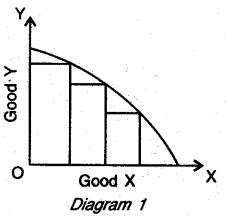
Question.7. 8 units of a good are demanded at a price of Rs 7 per unit. Price elasticity of demand is (-) 1. How many units will be demanded if the price rises to Rs 8 per unit? Use expenditure approach of price elasticity of demand to answer this question.
Answer.

Question.8. Giving examples, explain the meaning of cost in economics.
Answer. Cost in economics is the sum of:
- Explicit cost which is actual money expenditure on inputs, for example purchase of materials etc.
- Implicit cost is the estimated value of the inputs supplied by the owners including normal profit, for example, estimated salary of the owners etc.
Question.9. Draw average revenue and marginal revenue curves in a single diagram of a firm which can sell more units’of a good only by lowering the price of that good. Explain.
Answer. This is a case of monopoly and monopolistic competitive market situation. In these markets a firm can sell more of its products only when it lowers down the price. This means AR (Price) curve slopes downwards to the right. When AR slopes downwards to the right, has a negative slope. MR is less than it. It can be mathematically derived. Thus, as shown in the diagram, AR > MR. This also becomes evident by looking at the schedule given below.

Distinguish between Average’ and Marginal Revenue with the help of a numerical example.
Question.10. Explain the implication of ‘freedom of entry and exit to the firms’ under perfect competition.
Answer. An important characteristic feature of perfect competition is the freedom of entry and exit to the firms. Because of this aspect a competitive firm in the long run gets only normal profit, i.e. AR = AC. If the existing firms are getting abnormal profit (i.e. AR > AC), few more firms will enter the competition and the same disappears. If, on the other hand, few existing firms are incurring losses (AR < AC), they leave the competition and the remaining firms get normal profit.
Or
Explain the implication of ‘perfect knowledge about market’ under perfect competition.
Answer. Under perfect competition all buyers and sellers have perfect knowledge about the market conditions. With the result, goods being homogeneous, the same price prevails. A firm cannot charge higher price because the buyers know that it is available at a lesser price elsewhere. Similarly, a firm will not charge lesser price, because it will be imprudent to do so, for it can get the same price which other firms are getting. As a result uniform price prevails in the market.
Question.11. A consumer consumes only two goods X and Y. State and explain the conditions of consumer’s equilibrium with the help of utility analysis.
Answer. See Q. 14 (Or), 2009 (I Delhi).
Question.12. Explain how the demand for a good is affected by the prices of its related goods. Give examples.
Answer. Related goods may be of two types—(i) Substitute goods and (ii) Complementary goods.
(i) Effect of change in the prices of Substitute goods. Substitute goods are those which can be used in place of one another, such as tea and coffee. When price of coffee (a substitute good) increases, the demand for tea increases because now coffee becomes costlier in comparison to tea. The reverse of it will happen when the price of coffee falls.
(ii) Effect of change in prices of Complementary goods. Complementary goods are those which cannot be used without one another, such as, pen and ink. If die price of ink (a complementary good) goes up, its demand will fall and this would lead to a fall in the demand for pens. The reverse of it will happen when the price of ink falls.
Question.13. Define ‘Market-supply’. What is the effect on the supply of a good when Government imposes a tax on the production of that good? Explain.
Answer. Market supply is the total supply (supply of all firms in the market) of a good at a price at a time. It is obtained by adding up individual supplies of all the firms. When a government imposes a tax on the production of a commodity, its cost goes up. With the result, its supply falls at a given price. Thus, as shown in diagram 3, supply curve shifts towards left. Supply schedule is a two column table, which shows various quantities supplied corresponding to prevailing market prices at a time. A hypothetical supply schedule of commodity X is given below:

Or
What is a supply schedule? What is the effect on the supply of a good when Government gives a subsidy on the production of that good? Explain.
Answer. A supply schedule is a two column table wherein the quantity supplied corresponding to the given prices of a commodity is indicated. A hypothetical supply schedule is given below. Subsidy is a grant given by the Government to the producers so that they can sell their products at a lesser price. Thus, when Government gives subsidy, the cost of production goes down and this enables the producing firms to increase the supply at the same price. Thus, as shown in diagram 4, a shift towards right in the supply curve takes place.

Question.14. What is meant by producer’s equilibrium? Explain the conditions of producer’s equilibrium through the ‘total revenue and total cost’ approach. Use diagram.
Answer. See Q. 11, 2008 (I Delhi)
For Blind candidates in lieu of Q. No. 14
What is meant by producer’s equilibrium? Explain the conditions of producer’s equilibrium through the ‘total revenue and total cost approach’. Use a schedule.
Answer. See Q. 11, 2008 (I Delhi)
Question.15. Explain the three properties of indifference curves.
Answer. (i) An indifference curve always slopes downwards to the right. In other words, it has a negative slope. To consume more of one good, the consumer must give up some quantity of the other good so that total utility remains the same.
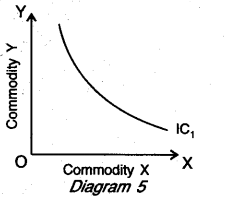
(ii) Higher indifference curve denotes higher level of satisfaction. This is because higher IC represents more of at least one commodity, which means more utility as more is preferred to less.

(iii) Two indifference curves never intersect each other because at the point of intersection, the level of satisfaction is the same but at other points it is hot tire same. It is not possible. Therefore, it is wrong to suggest they intersect as shown in Diagram 7.

Question.16. Market for a good is in equilibrium. There is an ‘increase’ in demand for this good. Explain the chain of effects of this change. Use diagram.
Answer.
- ‘Increase’ in demand shifts the demand curve from D1 to D2 to the right leading to excess demand E1F at the given price OP1.
- Since the consumers will not be able to buy all they want to buy at this price, there will be competition among buyers leading to rise in price.
- As price rises, demand starts falling (along D2) and supply starts rising (along S) as shown by arrows in the diagram.
- This change continues till D and SS are equal atli2.
- The quantity rises to OQ2 and price to OP2.

For blind candidates only in lieu of Q. No. 16 Market for a good is in equilibrium. There is an ‘increase’ in demand for this good. Explain the chain of effects of this change. Use a numerical example.
Answer. Chain of Effects: Same as Q. 16.
Market is in equilibrium when quantity demanded and quantity supplied are equal. In the given example, as indicated in the table, equilibrium price and quantity are Rs 7 and 15 respectively. However, when demand increases, say due to an increase in income the new equilibrium price and quantity are Rs 8 and 20. Thus, when demand increases, price and quantity both increase.

Or
Distinguish between collusive and non-collusive oligopoly. Explain how the oligopoly firms are interdependent in taking price and output decisions.
Answer. Collusive oligopoly, also known as cooperative oligopoly, is that where firms cooperate with each other in determining the price or output or both. On the other hand, non-collusive or non-cooperative oligopoly is that where firms compete with each other in determining – price or output or both.
In oligopoly, there are few dominant firms and they are free to determine price and output of their product. However, in real practice, they are not free to do so. They do not change price independently because they have the fear of retaliation by other firms. For example, if they raise the price and other firms do not raise their prices, they lose the market. On the other hand, if they lower the price and other firms also revise the price, the benefit of lowering the price goes away. As such firms mutually depend on each other regarding their decisions about price and output.
SECTION B
Question.17. What is nominal gross domestic product?
Answer. The gross money value of final goods and services at current prices produced within the domestic territory of a country in an accounting year is nominal gross domestic product. When GDP of a given year is estimated on the basis of price of the same year, it is called nominal GDP.
Question.18. Define flow variables.
Answer. Those economic variables whose value can be estimated during a period of time are flow variables such as income.
Question.19. Define cash reserve ratio.
Answer. It is a part/portion of the total deposits with the commercial banks, which they are legally required to keep in reserve with the central bank of the country.
Question. 20. Define money supply.
Answer. It is the total amount of money held by the public at a point of time in an economy.
Question. 21. Define foreign exchange rate.
Answer. Foreign exchange is the price of a foreign currency in terms of domestic currency.
Question. 22. State the components of capital account of balance of payments.
Answer. The components of capital account of balance of payments are the following:
- Borrowings and lendings to and from abroad.
- Investments to and from abroad.
- Changes in foreign exchange reserves.
Question.23. Explain how ‘distribution of gross domestic product’ is a limitation in taking gross domestic product as an index of welfare.
Answer. The manner in which increase in gross domestic product is distributed, also affects economic welfare. It is possible that with rise in GDP, inequalities in the distribution of income may also increase. If increase in GDP increases income inequalities, the increase in economic welfare may not be equal to the increase in GDP. It means gap between rich and poor increases. Increase in the welfare of the rich is less in comparison to the increase in the welfare of the poor.
Question.24. Given that national income is Rs 80 crore and consumption expenditure Rs 64 crore, find out average propensity to save. When income rises to Rs 100 crore and consumption expenditure to Rs 78 crore, what will be the average propensity to consume and the marginal propensity to consume?
Answer.

Question.25. Explain the relationship between investment multiplier and marginal, propensity to consume.
Answer.

It shows a direct relationship between MPC and the value of multiplier. Higher the proportion of increased income spent on consumption, higher the value of the multiplier.
Question.26. When price of a foreign currency rises, its demand falls. Explain why.
Answer. When price of foreign currency rises it becomes costly i.e. more domestic currency is paid for buying a unit of foreign currency. This leads to fall in demand as imports become costlier and it becomes more expensive to invest abroad. Hence the demand for foreign currency falls when its price rises.
Or
When price of a foreign currency rises, its supply also rises. Explain why.
Answer. When the price of foreign currency rises, its supply rises because more domestic currency is paid for obtaining one unit of foreign currency. This makes domestic goods cheaper and encourages exports. Also the foreign residents find it lucrative to invest here and therefore die supply of foreign currency increases.
Question.27. Explain the ‘allocation of resources’ objective of Government budget.
Answer. An important objective of Government budget is to allocate resources for accomplishing socio-economic objectives of the Government. Government can influence allocation of resources through (i) tax concessions, subsidies etc. and (ii) directly producing goods and services. Resources may be allocated for increasing investment, reducing income inequalities, providing better health care and education facilities.
Or
Explain the ‘redistribution of income’ objective of Government budget.
Answer. Through the budget, the Government may like to affect pattern of redistribution of income. For achieving it, Government has a number of fiscal tools at its disposal, such as taxation> subsidies, public expenditure, etc. Government can influence distribution of income by imposing taxes on the rich and spending more on the welfare of the poor. This will reduce income of die rich and raise standard of living of the poor.
Question.28. From the following data about a Government budget, find out (a) Revenue deficit, (b) Fiscal deficit and (c) Primary deficit.

Answer. (a) Revenue Deficit
Revenue expenditure (if) – Revenue receipts (iv)
= 100 – 80 = Rs 20 arab.
(b) Fiscal deficit .
Revenue expenditure + Capital expenditure – Revenue receipts – Capital receipts net of borrowings
= 100 + 110 – 80 – 95 = Rs 35 arab.
(c) Primary deficit
Fiscal deficit – Interest payments
= 35 – 10 = Rs 25 arab.
Question.29. Giving reasons, classify the following into intermediate products and final products.
(i) Furniture purchased by a school.
(ii) Chalks, dusters, etc. purchased by a school.
Answer. These are durable use producers’ goods.
(i) Furniture for a school is a part of capital formation and thus is a final product.
(ii) Chalks, dusters etc. are intermediate products because these are being used up in the process of production of teaching services in a school. They are not needed or their own sake but for producing teaching services.
Question.30. Explain the role of the following in correcting deficient demand’ in an economy:
(i) Open market operations
(ii) Bank rate
Answer. The situation of deficient demand exists when at the full employment level, aggregate demand is less than aggregate supply. This creates the problem of involuntary unemployment. For tackling this problem, the level of aggregate demand needs to be increased for which, besides other things, volume of credit should be increased.
(i) Open market operations refer to the sale and purchase of securities by the central bank. In the situation of deficient demand, central bank buys securities in the open market and makes payment to the sellers. The money flows out of the central bank and ultimately reaches the commercial banks as deposits. This raises the lending capacity of the banks. People can borrow more and this will raise aggregate demand.’
(ii) Bank rate is the rate of interest which central bank charges from commercial banks for giving them credit. However, the relationship between rate of interest and demand for credit is inverse. Thus, when bank rate is increased, rate of interest increases and demand for credit falls. Thus, in case of deficient demand, bank rate should be lowered. This will lead to a fall in the rate of interest, finally leading to an increase in the demand for credit. This will raise aggregate demand.
Or
Explain the role of the following -in correcting ‘excess demand’ in an economy:
(i) Bank rate
(ii) Open market operations
Answer. The situation of excess demand exists when, at the equilibrium level, aggregate demand is more than aggregate supply. This generates inflationary forces and there is no increase in real output. Therefore, the situation needs to be rectified by reducing the level of aggregate demand. For that:,
(i) Bank rate is that rate of interest at which the central bank lends to commercial banks. To correct excess demand, central bank can raise the bank rate. This forces commercial banks to increase lending rates. This reduces demand for borrowing by the public for investment and consumption. Aggregate demand falls.
(ii) Open market operations refer to the sale and purchase of securities by the central bank in the open market, excess demand refers to AD exceeding AS at the full employment level of income. In this situation, the central bank can sell securities receiving payments from its buyers. The money flows out of the commercial banks into the central bank. This reduces the lending capacity of the banks and in turn reduces aggregate demand.
Or
Explain the role of the following -in correcting ‘excess demand’ in an economy:
(i) Bank rate
(ii) Open market operations
Answer. The situation of excess demand exists when, at the equilibrium level, aggregate demand is more than aggregate supply. This generates inflationary forces and there is no increase in real output. Therefore, the situation needs to be rectified by reducing the level of aggregate demand. For that:,
(i) Bank rate is that rate of interest at which the central bank lends to commercial banks. To correct excess demand, central bank can raise the bank rate. This forces commercial banks to increase lending rates. This reduces demand for borrowing by the public for investment and consumption. Aggregate demand falls.
(ii) Open market operations refer to the sale and purchase of securities by the central bank in the open market, excess demand refers to AD exceeding AS at the full employment level of income. In this situation, the central bank can sell securities receiving payments from its buyers. The money flows out of the commercial banks into the central bank. This reduces the lending capacity of the banks and in turn reduces aggregate demand.
Question.31. Explain the process of money creation by the commercial banks with the help of a numerical example.
Answer. The money (or deposit or credit) creation by the commercial banks is determined by die amount of initial deposit and the legal reserve ratio (LRR). Suppose the amount of initial deposit is Rs 10,000 and LRR 0.2. The banks will keep 20% i.e. Rs 2,000 as reserve and lend the remaining Rs 8,000. Those who borrow spend this money. It is assumed that Rs 8,000 comes back to the banks. This raises total deposits to Rs 18,000. Banks again keep 20% of Rs 8,000 i.e. Rs 1,600 as reserve and lend Rs 6,400. This further raises the amount of deposits with the banks. In this way deposits go on increasing @ 80% of the last deposit. How many times will these deposits be is determined by the deposit multiplier.
Money multiple = (frac { 1 }{ LRR } =frac { 1 }{ 0.2 } =5)
The total deposits will be:
Total money creation = Initial deposit x Money multiplier = 10,000 x 5 = Rs 50,000
Question.32. Calculate National Income and Gross National Disposable Income from the following:

Answer. National Income
= Private final consumption expenditure + Government final consumption expenditure + Net domestic fixed capital formation + Change in stocks – Net imports – Net indirect tax – Net factor income to abroad = (ii) + (v) + (vii) + (ix) – (viii) – (vi) – (iv)
= 500 + 200 + 120 + (-20) – 30 – 100 – (-10)
= 830 -150 = 7 680 crores
Gross National Disposable Income
= National Income + Consumption of fixed capital + Net indirect tax – Net current transfers to the rest of the world
= 680 + 20 + 100 – (-5) = Rs 805 crores
SET II
Note : Except for the following questions, all the remaining questions have been asked in Set I.
SECTION A
Question.1. What is positive economics?
Answer. Positive economics deals with the actual facts without making any value judgements. Positive economics deals with ‘what is’ without making any value judgement.
Question.7. A consumer buys 10 units of a good at a price of Rs 6 per unit Price elasticity of demand is (-) 1. At what price will he buy 12 units? Use expenditure approach of price elasticity of demand to answer this question.
Answer. According to expenditure approach, when elasticity of demand is -1 or 1, the total expenditure does not change when price or demand changes.

Therefore, at a price of Rs 5 the consumer will buy 12 units.
Question.11. Explain the conditions determining how many units of a good the Consumer will buy at a given price.
Answer. Marginal utility of successive units keeps on declining but price remains the same. Consumer keeps on consuming so long as marginal utility is greater than the price. He stops buying at a point where marginal utility is equal to the price. In short,
Marginal Utility = Price.
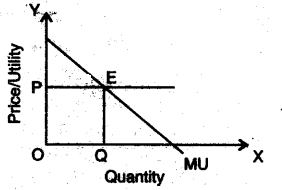
As shown in the diagram, a consumer will buy OQ quantity of a commodity because at this level MU is equal to price.
Question.15. Explain the concept of Marginal Rate of Substitution (MRS) by giving an example. What happens to MRS when consumer moves downwards along the indifference curve? Give reasons for your answer.
Answer. Marginal Rate of Substitution (MRS) may be defined as the amount of Y sacrificed for obtaining an additional unit of X. Say for obtaining an additional unit of X, 4 units of Y are foregone,
Then MRS = (frac { Delta Y }{ Delta X } =frac { 4 }{ 1 } =4)
MRS keeps on declining as we go on using more and more units of Y. This is because of the application of law of diminishing marginal utility. When we go on substituting Y by X, we forego units having more utility. Naturally, more and more units of Y will be foregone for successive additional units of X. This shows MRS is declining.
SECTION B
Question.22. State the components of current account of Balance of Payments.
Answer. Components, of. current account of balance of payments:
- Exports and imports of goods
- Exports and imports of services
- Income receipts and payments to and from abroad
- Transfers to and from abroad.
Question.24. If National income is Rs 50 crore and Saving Rs 5 crore, find out average propensity to consume. When income rises to Rs 60 crore and saving to Rs 9 crore, what will be the average propensity to consume and the marginal propensity to save ?
Answer.
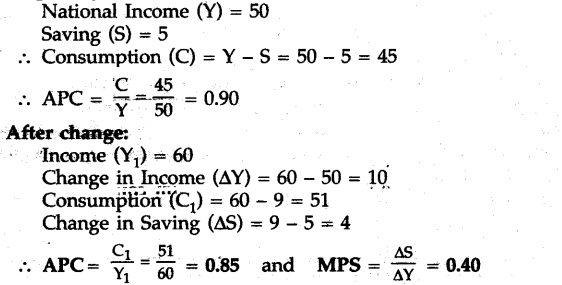
Question.29. Giving reasons Ossify the following into intermediate products and final products:
(i) Computers installed in an office
(ii) Mobile sets purchased by a mobile dealer
Answer. (i) Computes installed in an office are for investment purpose and hence a final product.
(ii) Mobile Sets are for resale and hence are intermediate products.
Question.32. Find out Gross National Product at Market Price and Net National Disposable Income from the following:

Answer.

SET III
Note: Except for the following questions, all the remaining questions have beg# asked in Set I and Set II.
SECTION A
Question.1. What is normative economics?
Answer. Normative economics deals with what ought to be based on value judgement.
Question.7. When the price of a good changes to Rs 11 per unit, the consumer’s demand falls from 11 units to 7 units. The price elasticity of demand is (-) 1. What was the price before change? Use expenditure approach of price elasticity of demand to answer this question.
Answer.

Question.11. Derive the law of demand from the single commodity equilibrium condition “marginal utility = price”.
Answer. The price and quantity demanded of a good are usually inversely related. This means when price is more, demand is less and vice-versa. This inverse relationship between price and demand can be exhibited using single commodity equilibrium condition. Marginal Utility (MU) – Price.
The law of diminishing marginal utility states that if we successively go on consuming more units of the same commodity, the utility which we derive from such successive unit (i.e., its MU) declines. Knowing this, one will have (or demand) more of a good when its price is less and vice-versa, because now he is having units yielding less satisfaction. The reverse of it will be true in opposite directions.

Thus, given the law of diminishing marginal utility, we have a downward sloping MU curve and. given the equilibrium condition, MU = Price, for a single commodity The demand curve of the commodity coincides with the MU curve (in the positive quadrant only). As shown in Diagram, the equilibrium quantity will be OQ because at this level MU and price of the commodity are equal.
Question.15. What are monotonic preferences? Explain why is an indifference curve (i) Downward sloping from left to right and (ii) Convex.
Answer. A consumer’s preferences are monotonic only if between any two bundles, the consumer prefers that bundle which has more or (east one of the goods and no less of the other good as compared to the other bundle.
(i) An indifference curve slopes downward from left to right. A downward sloping . indifference curve shows that if a consumer has more of one good he will have less of the other good because the level of satisfaction remains the same.
(ii) An indifference curve is convex to the origin. It is because of the fact that marginal rate of substitution is declining. Marginal rate of substitution declines because of the law of diminishing utility. As such, as a consumer has more of good X, he foregoes less units of good Y.
SECTION B
Question.22.What does balance of payments account show? Name the two parts of the balance of payments account.
Answer. Balance of payments account shows a country’s inflows and outflows of foreign exchange. Two parts of BOP are:
(i) The Current Account
(ii) The Capital Account
Question.24. If. National Income is Rs 90 crore and consumption expenditure Rs 81 acre, find out average propensity to save When income rises to Rs 100 crore rod consumption expenditure to Rs 88 crore, what will be the marginal propensity to consume and marginal propensity to save?
Answer.
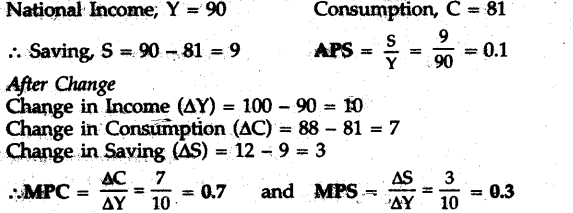
Question.29.Giving reason identify whether the following are final expenditures or intermediate Expenditure :
(i) Expenditure on maintenance of an office -building.
(ii) Expenditure on improvement of a machine in a factory.
Answer. (i) Expenditure on imaintenance of an office building is an intermediate expenditure because it involves expenditure on goods which are single use producer goods.
(ii) Expenditure on improvement of a machine in a factory will be treated as final expenditure because it is expenditure on investment.
<!–
–>